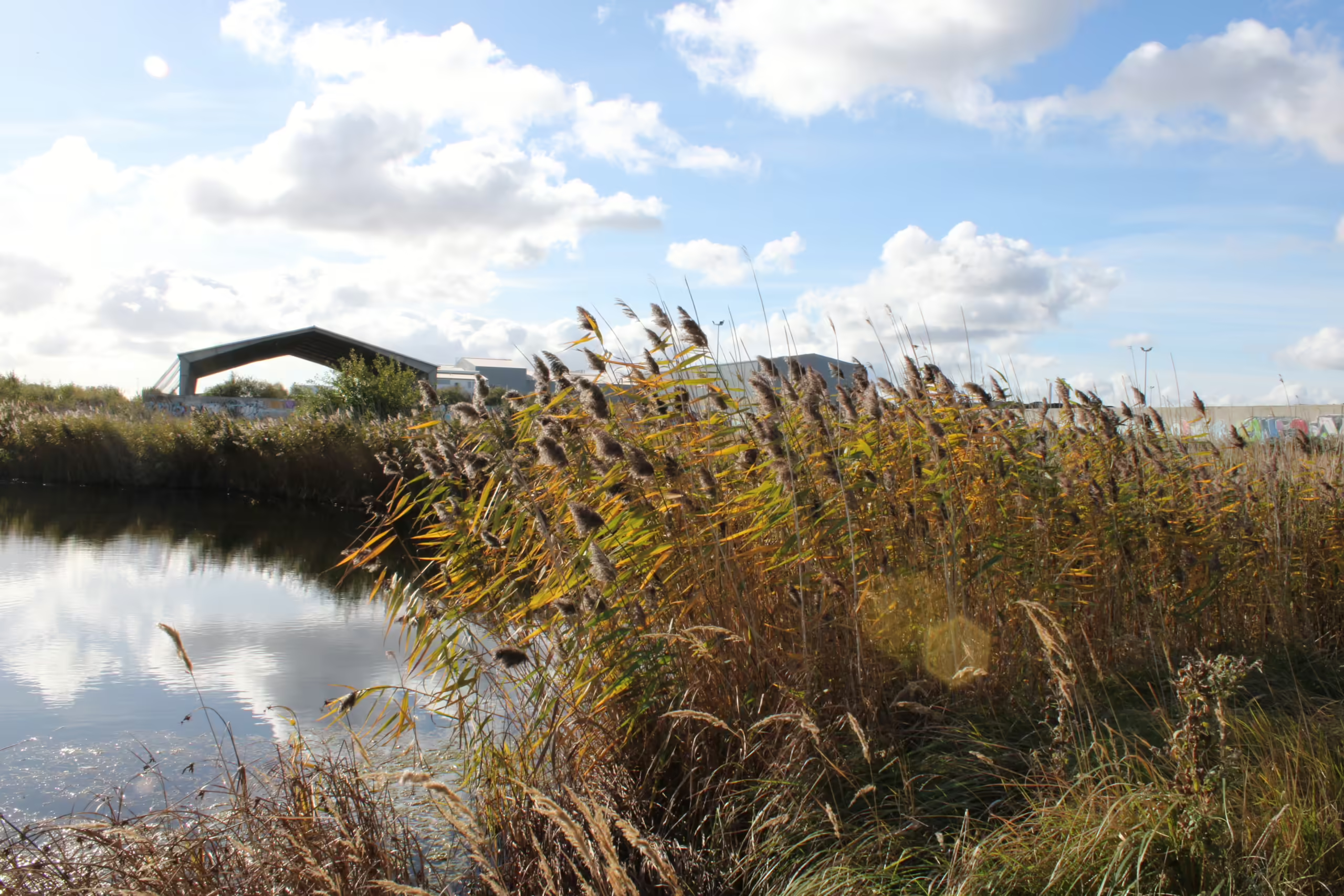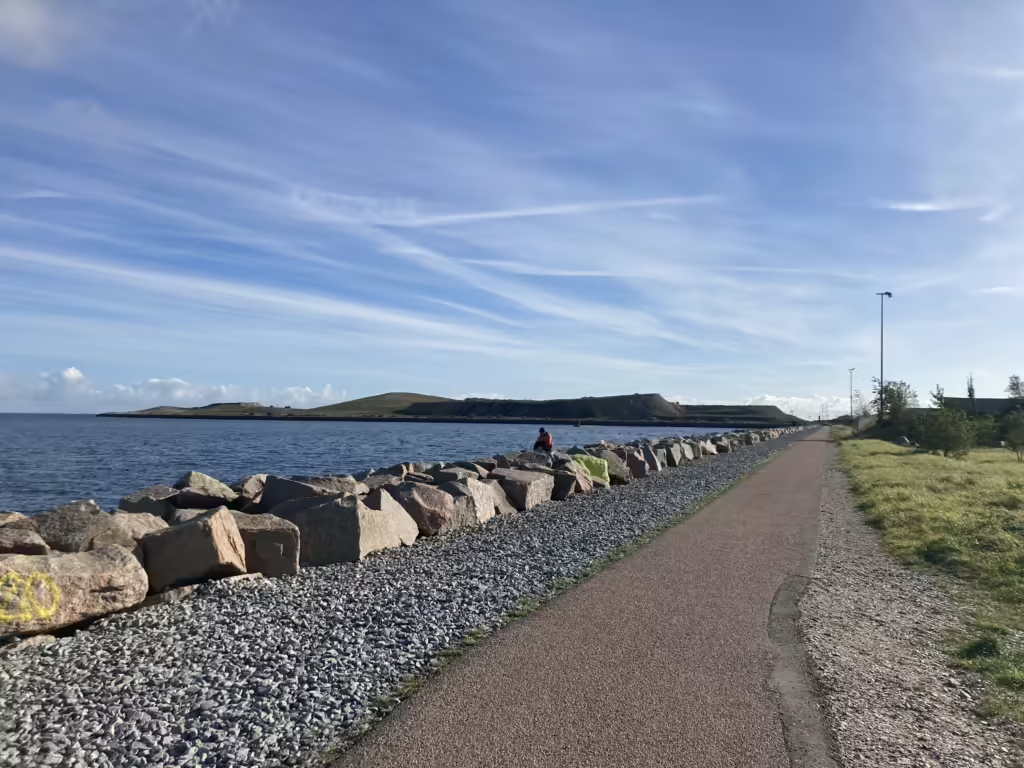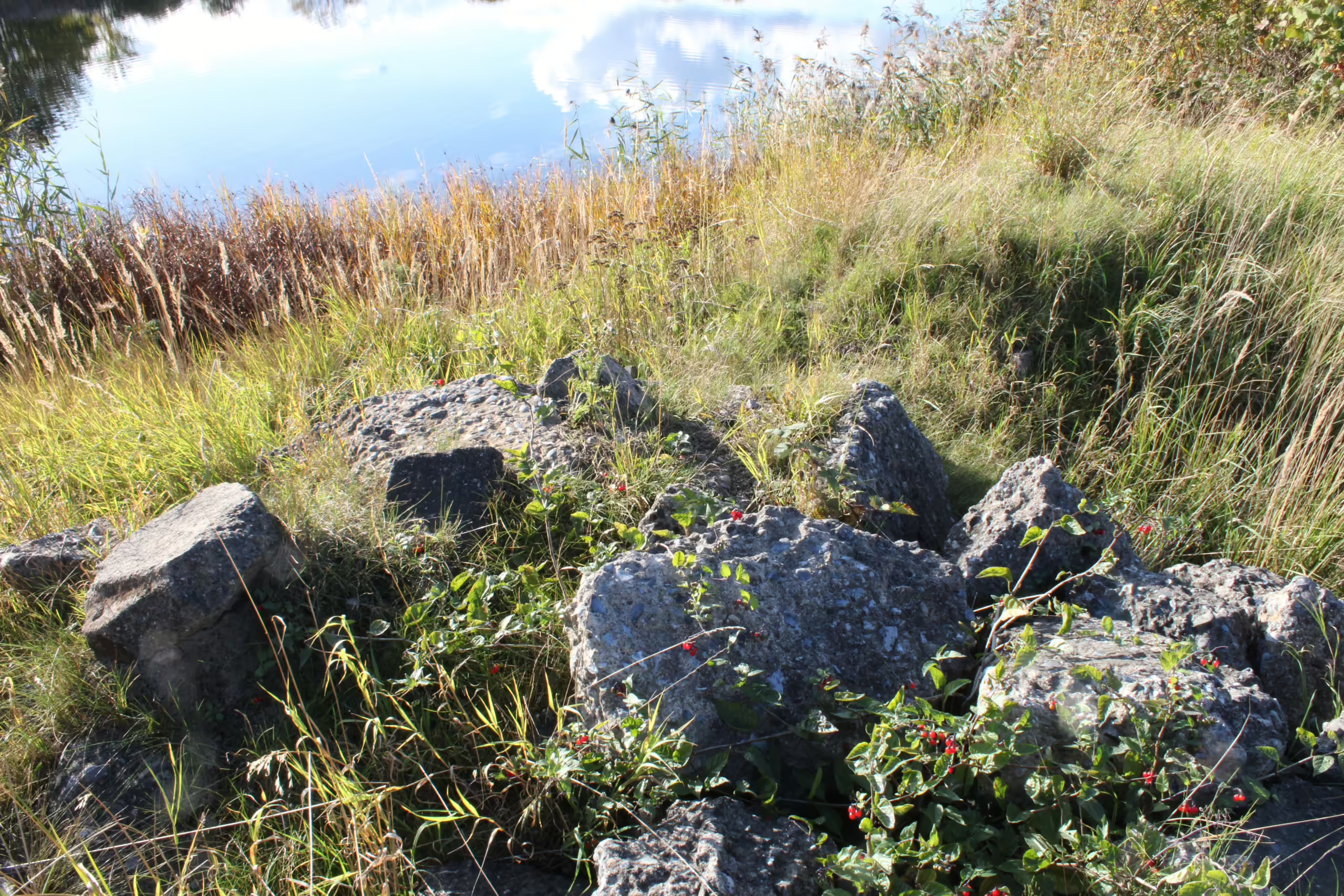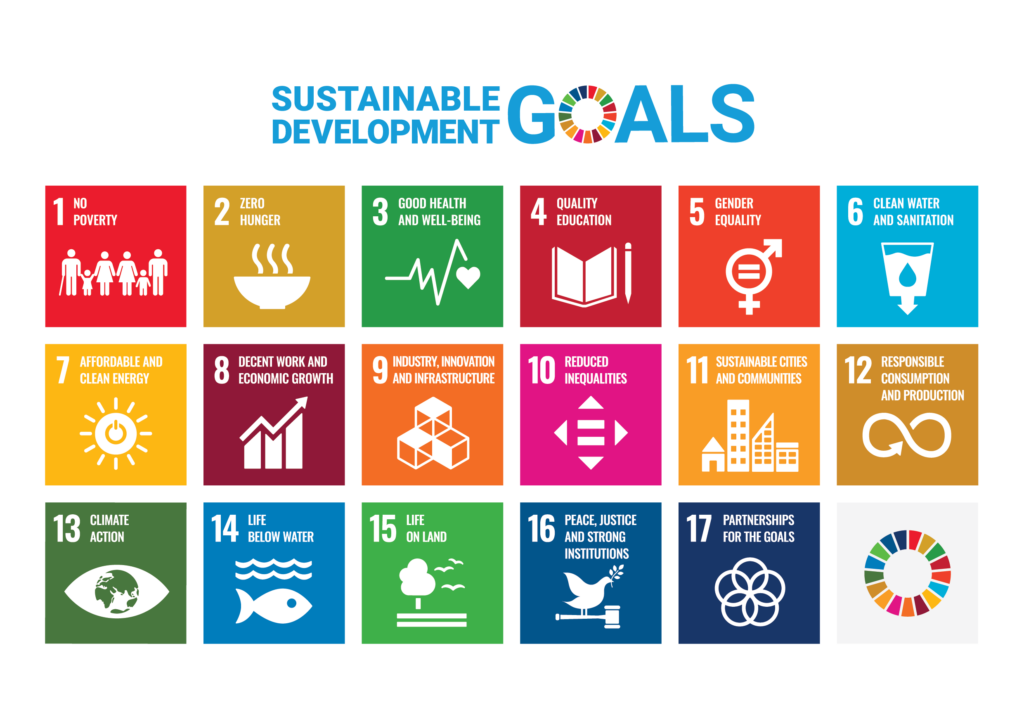
Written by Natalia Rodriguez Castañeda
Social, Environmental and health anthropologist PhD Candidate at NovelEco research group – Trinity College Dublin
The Natural Park “Nordhavnstippen” is located in Nordhavn, or as its Danish name means, in the north harbour of Copenhagen. This site, for decades, has been an industrial and port area of the city.
However, Nordhavnstippen is a transition and post-industrial area that was abandoned and fenced for decades and where large grasses and shrubs have covered industrial waste, creating a semi-natural, wild and biodiverse area in the north side of Copenhagen. Nordhavnstippen is an accessible green space in Copenhagen today, where people have the opportunity to explore and experience wild nature in the city. Moreover, this case study represents an opportunity to reflect on the role of wild nature when we consider sustainable development and planning in urban settings. Also, this invites us to explore methodological approaches, such as multispecies ethnography, to study the value of these spaces for people and the biodiversity that inhabits and interacts with this type of urban nature. In the case of Nordhavnstippen, these questions are especially relevant as Nordhavn, a district in Copenhagen, is under a significant transformation and expansion towards Scandinavia’s largest sustainable project – where a vacant industrial area is being transformed into a new sustainable urban district – (Danish Architecture Centre (DAC), 2023).

Map taken from: https://www.google.com/maps/@55.7166626,12.6088703,14.21z?entry=ttu
February 2024
When you visit Norhavnstippen by bike or public transportation – taking the line M4 or Bus 164 – you can notice that Nordhavn is an area under urban renovation. Here, you can perceive that this district of Copenhagen has different landscapes and contrasts that go from the metro station Orientkaj, new and modern architecture, old industrial buildings, vacant lands waiting for development, large cranes as part of the cityscape, and container terminals. This area may feel polluted, overwhelmed and noisy. However, when you reach the point of TunnelFabrikken and continue straight to reach the sea coast – Ydre Nordhavn, you can find a 28ha area with overgrown grasslands, ponds, and spontaneous vegetation growing free, covering industrial and construction waste and making a post-industrial landscape into a place to relax, contemplate and have contact with wild nature in Copenhagen. As one interviewee describes, this natural site in Copenhagen is “a place where nature sets free, and where you can feel in contact with wild nature in the city”. This is Nordhavnstippen, a blue and green space where nature emerges, shaping the landscape and co-existing and co-habiting with multiple species. A semi-natural area that alludes to its industrial and polluted past and moves towards a sustainable future, exposing the importance of embracing spontaneous, emerging, wild and natural forms in the design and planning of recreational and natural areas in cities.


Photo taken by Natalia Rodríguez Castañeda, October 2023. Visit to Nordhavnstippen.
In the wildness areas of Nordhavnstippen, multispecies assemblages proliferate. Birds, plants, microorganisms, fungi, and even algae co-habit and co-exist with people who find a place for relaxation, contemplation, and recreation in this space. Therefore, when we contemplate how these spaces can be integrated into notions of “urban planning” and “sustainable development”, we should keep in mind that urban wild spaces, such as Nordhavnstippen, are interstitial spaces that are often “found hidden between the facades of buildings – the “slots”, nooks, and crannies of the city” (Sankalia, 2008, p. 29). These spaces are multispecies sites where “multispecies assemblages in zones of wildness that proliferate beyond realms of human influence and control” (van Doreen et al., 2016, p. 6). Consequently, for its urban and sustainable planning, we need to integrate socio-ecological and more-than-perspectives that help us engage with human and non-human agencies that build and shape these wild spaces in cities. One way to bring this into discussion and into research is through the “multispecies ethnography” methodology.
Ethnography is a qualitative and descriptive methodology used mainly in the field of anthropology and the social and behavioural sciences to collect, write and record data from participant observations, interviews or fieldwork. This method was initially used to study and understand the other, such as “other’s culture”, “other’s social behaviour”, or “other’s kinship”, focusing mainly on the study of humans and socio-cultural ambits (Sarukkai, 1997). However, more recently, there has been a shift towards the emergence of multispecies ethnography, where “creatures previously appearing on the margins of anthropology – as part of the landscape, as food for humans, as symbols – have been pressed into the foreground in recent ethnographies” (Kirksey & Helmreich, 2010, p. 545). This focus towards multispecies or more-than-human approaches acknowledges that “we are always entangled in multiple relations with others (human and non-human) – and that these are often imbalanced” (Steele et al., 2019). This method invites uncovering human-non-human relationships by recognizing that animals, plants and other living and non-living beings are also subjects that continuously and reciprocally interact with humans and non-humans. This helps to integrate novel narratives, subjects, voices, experiences, meanings and knowledges that contribute to re-significate spaces and relationships between human nature, and, in this case, to question notions of development and planning in cities.
In the case of Nordhavnstippen, an emergent wild and semi-natural area embedded in a large urban renovation project, it may be beneficial to integrate a multispecies ethnography perspective that contributes to creating new narratives around urban sustainability and urban wild nature. A multispecies ethnography perspective may include the study of urban planning of interstitial spaces from an approach that brings together human and non-human beings as subjects rather than objects, including “other voices” and “other agencies” in the shaping, construction and protection of this wild and abandoned landscape that has been re-covered and re-colonized by spontaneous vegetation, shrubs and grasses. In this sense, multispecies ethnography invites a dialogue between citizens, policymakers and local knowledge around biodiversity in Nordhavnstippen. It creates opportunities to envision Nordhavnstippen as a place for wild nature, recreation, nature connectedness and sustainability in Copenhagen. Also, it raises the challenge of engaging with non-human beings, such as animals, plants, and microbes, among others, in urban planning and how to bring their voices and agencies into designing, managing and ecological functioning of wild or interstitial spaces in cities.
From a sustainable development perspective, a multispecies ethnography approach may be useful in creating novel narratives that make us question what development and sustainability mean in an urban and globalized context. In this case, for example, a multispecies ethnography may engage with the Sustainable Development Goals (SDGs) as interlinked and interdependent goals that can be accounted for and implemented in a holistic, comprehensive and participatory approach. In an urban case study such as Nordhavnstippen, we can engage first with SDG 11 – Sustainable cities and communities – recognizing that in order to achieve this goal, we need to think in cities able to mitigate and cope with extreme environmental changes caused by climate change (SDG 13. Climate action). Moreover, we need to prioritize the conservation of land and aquatic ecosystems and their biological diversity (SDG 14. life below water and SDG 15. Life on land) and consider how these spaces may help to promote social and environmental justice as having equal access, participation and right to nature in Copenhagen (SDG 17. Peace, justice and strong institutions). Furthermore, this may be aligned with targets related to affordable and clean energy (SDG. 7) by promoting clean and affordable public transportation to visit this area. This is just an example of how we can use multispecies narratives to help us achieve sustainable agendas by engaging with citizens, institutions, and complex socio-ecological systems in urban settings.

Finally, a multispecies ethnographic approach that comprises multiple human and non-human actors and social and environmental issues may be a beginning for studying, planning and designing green spaces in cities where nature sets free, changing our conception of aesthetics and urban nature in the era of the Anthropocene and contributing that wild, spontaneous and ruderal spaces play a role that helps us to conceive green spaces more resilient and adapted towards climate change, biodiversity loss or urban sprawl. In other words, contemplate cities and green spaces for everyone and ensure a sound, green and inclusive transition in the sustainable planning of cities.
Note. This blog note was written based on personal reflections and insights from my PhD research stay at the University of Copenhagen from September to December 2023 in collaboration with Natalie Gulsrud and Megan Lynn Maurer, professors associated with the Faculty of Landscape and Urban Planning. This research focuses on wild nature and One Health in cities, this takes Nordhavnstippen as a potential case study.
Other sites and initiatives that may be worth visiting in Copenhagen.
References
Danish Architecture Centre (DAC). 2023. “Sustainable city for the future”. Available online: https://dac.dk/en/knowledgebase/architecture/nordhavn-2/
Sankalia, T., 2008. “From facade to interstitial space: reframing San Francisco’s Victorian residential architecture”. In: Alsayad, N. (Ed.), The Cultural Politics of Dwellings: Traditional Dwellings and Settlements. Working Paper Series, vol. 213. Centre for Environmental Design Research, University of California, Berkeley, pp. 27–52.
Van Dooren, T; Kirksey, E & Münster, U. 2016. “Multispecies Studies. Cultivating Arts of attentiveness”. In: Environmental Humanities 8 (1). Published by Duke University Press. May 2016. Available on: https://epub.ub.uni-muenchen.de/37872/1/10.1215_22011919-3527695.pdf
Sarukkai, Sundar. 1997.“The ‘Other’ in Anthropology and Philosophy.” Economic and Political Weekly 32, no. 24 (1997): 1406–9. http://www.jstor.org/stable/4405512.
Kirksey, E & Helmreich, S. 2010. “The emergence of multispecies ethnography”. Cultural Anthropology. Vol 25. Issue 4, pp. 545-576. Doi: 10.1111/j.1548-1360.2010.01069.x
Steele, W., Wiesel, I., & Maller, C. (2019). More-than-human cities: Where the wild things are. Geoforum, 106, 411–415. https://doi.org/10.1016/j.geoforum.2019.04.007 United Nations. 2023. Sustainable Development Goals. Department of Economic and Social Affairs. Available on: https://sdgs.un.org/goals